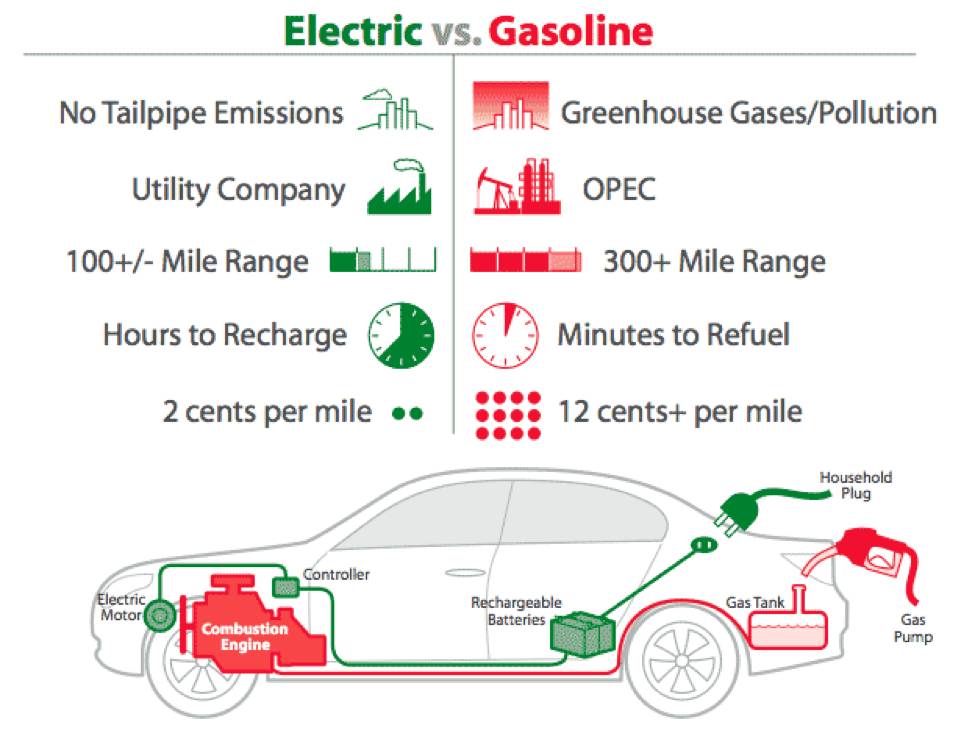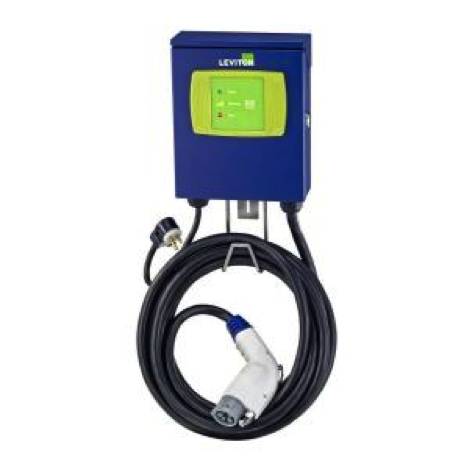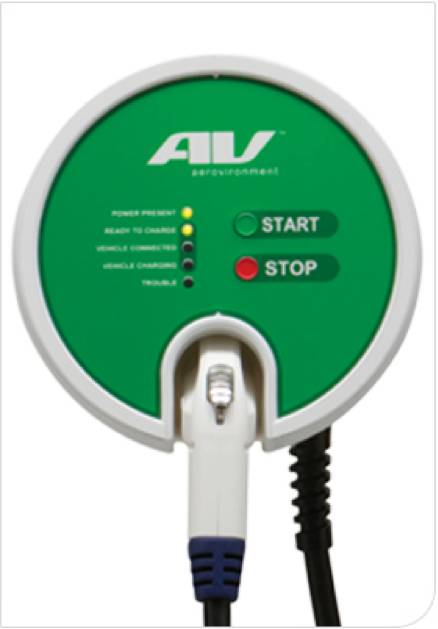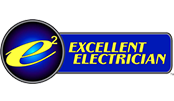Electric Cars: What is an Electric Car?
An electric car is powered by an electric motor instead of a gasoline engine. The electric motor gets energy from a controller, which regulates the amount of power—based on the driver’s use of an accelerator pedal. The electric car (also known as electric vehicle or EV) uses energy stored in its rechargeable batteries, which are recharged by common household electricity.
Unlike a hybrid car—which is fueled by gasoline and uses a battery and motor to improve efficiency—an electric car is powered exclusively by electricity. Historically, EVs have not been widely adopted because of limited driving range before needing to be recharged, long recharging times, and a lack of commitment by automakers to produce and market electric cars that have all the creature comforts of gas-powered cars. That’s changing. As battery technology improves—simultaneously increasing energy storage and reducing cost—major automakers are expected to begin introducing a new generation of electric cars.
Under the hood, there are a lot of differences between gasoline and electric cars:
- The gasoline engine is replaced by an electric motor.
- The electric motor gets its power from a controller.
- The controller gets its power from an array of rechargeable batteries.
Electric cars produce no tailpipe emissions, reduce our dependency on oil, and are cheaper to operate. Of course, the process of producing the electricity moves the emissions further upstream to the utility company’s smokestack—but even dirty electricity used in electric cars usually reduces our collective carbon footprint.
- Energy efficient. Electric motors convert 75% of the chemical energy from the batteries to power the wheels—internal combustion engines (ICEs) only convert 20% of the energy stored in gasoline.
- Environmentally friendly. EVs emit no tailpipe pollutants, although the power plant producing the electricity may emit them. Electricity from nuclear-, hydro-, solar-, or wind-powered plants causes no air pollutants.
- Performance benefits. Electric motors provide quiet, smooth operation and stronger acceleration and require less maintenance than ICEs.
- Reduce energy dependence. Electricity is a domestic energy source.

Another factor is convenience: In one trip to the gas station, you can pump 330 kilowatt-hours of energy into a 10-gallon tank. It would take about 9 days to get the same amount of energy from household electric current. Fortunately, it takes hours and not days to recharge an electric car, because it’s much more efficient vs. gas. Speaking of convenience, let’s not forget two important points: charging up at home means never going to a gas station—and electric cars require almost none of the maintenance, like oil changes and emissions checks, that internal combustion cars require reducing overall maintenance cost.
Electric motors develop their highest torque from zero rpms—meaning fast (and silent) zero-to-60 acceleration times.
Note: In the illustration, we show the relative features of electric cars and gas-powered cars as a comparison. However, it doesn’t have to be an “either-or” situation. Plug-in hybrids offer many of the benefits of electric cars while mitigating most of the drawbacks, such as limited driving range and initial upfront cost.
Electric Car Chargers

Leviton’s Evr-Green Home Charging Stations enable quick charging of any SAE J1772 compatible Plug-In Electric Vehicle. The intuitive user interface and automatic features make the charging process extremely simple. The small footprint of these stations requires a minimum amount of valuable wall space for mounting. And, our patent pending mounting system allows for a do-it-yourself installation (when using cord-connected stations in conjunction with the Evr-Green Pre-Wire Kit)
- Tool-less, non-permanent installation also makes it easier to remove and replace or take with you in the event you move, when used in conjunction with Leviton’s EVK02 Installation Kit
- Built-in communication verifies proper connection before charging can commence
- Simple 1-button user interface, ADA compliant
- Auto-Restart feature enables charging to restart following a minor fault, thereby reducing the chance of being stranded with an undercharged battery
- Weatherproof NEMA Type 4 enclosure; safe for use in wet or dry locations
- Cord management bracket provides easy stowage of the charge connector when not in use
- Ground monitor circuit for safety
- “Hard-wired” unit available
- Call for your FREE in-home consultation: 1-800-466-3337 enter code 267. Installation services provided by The Home Depot authorized independent professionals
- MFG Brand Name : Leviton
- MFG Model # : 002-EVB22-3PM
- MFG Part # : 002-EVB22-3PM
Mount

Electric Vehicle Charging from GE
The wall mounted WattStation’s easy functionality and design allows for uncomplicated integration of fast Level 2 electric vehicle charging into your everyday activities. GE has partnered with ServiceMagic, the nation’s leading website connecting consumers with service professionals, to provide a network of certified electricians for reliable installation of the electric vehicle charger in the home. GE Capital, working with ServiceMagic, will provide financing options to qualified customers, enabling customers to pay for the charger and installation costs over time.
Features and Benefits
- Modern design: A smart, timeless design − the perfect complement to any EV.
- Simplicity: Plug the EV in and let it charge! A green backlit charging icon will illuminate to signal that the EV is in the process of charging. When charging is complete, users simply wrap the cord around the charging station, keeping it organized and out of the way.
- Reduced Energy Consumption: Completely shut off power to the WattStation, ensuring zero energy consumption when not in use.
- Installation: With easy to install mounting brackets, installation of the WattStation couldn’t be easier. A sturdy mounting plate with heavy-duty screws and a key lock keep the WattStation securely in place and prevent unwanted removal from the wall. A step-by-step installation video is available for contractors and homebuilders.
- Inside or outside: We’ve built a charger that is rugged enough to put outdoors. It’s NEMA 3R rating means it shrugs off rain and sleet, even a coating of ice.
- Hard Wired vs. Plug-in Unit: The WattStation wall mount can either be hard wired for more permanent installations or plugged in for simple removal of the unit. Choose the option that works best for you. It can be installed in new or existing construction.
- Standards Compliance: SAE J1772; NEC 625; UL 2231, 2251, 2594; NEMA and NIST; cUL 2594 and 2231.
Charging Dock

EVSE-RS*
Our Home Charging Dock model EVSE-RS charges your electric vehicle or plug-in hybrid (PHEV) while you sleep, enjoy a meal, or spend time with your family. Featuring a standardized connector, the EVSE-RS is designed to be compatible with EVs and PHEVs from all major automakers. EVSE-RS is weatherized for both indoor and outdoor installation in garages, carports or driveways.
Turnkey Installation The Home Charging Dock can be installed by one of our certified licensed electrical contractors who also perform diagnostics to verify installation, facilitate permitting and inspection, and conduct on-site customer orientation and training.**
Featuring
- Industry-approved SAE J1772 connector
- Outdoor-rated NEMA 4 enclosure
- Auto restart in event of power outage
- Breakaway safety cable and integrated stowage
- Auto short circuit and ground fault shutoff
- Protection against “live power”
- Optional pedestal mount
- Optional communication module


























